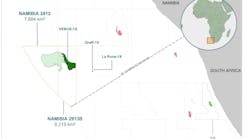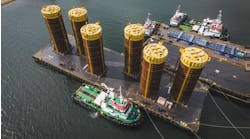Africa
ChevronTexaco Corp. subsidiary Chevron Overseas Congo Ltd. and its partners have a significant discovery at the Lianzi-1 exploration well in the deepwater area between Angola and Congo.
The discovery, in the shared 14K/A-IMI unit, is on the same stratigraphic trend as previous block 14 deepwater crude oil discoveries at Landana and Tombua in Angola.
Chevron drilled Lianzi-1 in 909 m of water and encountered two oil-bearing reservoirs. A drillstem test of one of the intervals flowed at a rate of more than 5,000 b/d of oil on a 40/64-in. choke.
“The Lianzi discovery is yet another addition to a number of excellent deepwater prospects in the region. These discoveries will provide a series of developments in the future and fuel production growth,” George Kirkland, president of ChevronTexaco Overseas Petroleum, says.
Jim Blackwell, managing director of ChevronTexaco’s Cabinda Gulf Oil Co., says, “We’ve long been optimistic about the exploration opportunities in the 14K/A-IMI shared unit, and this find helps to justify that optimism. The next step will be to complete several geologic and engineering studies to fully assess the field’s size, reserves potential, and possible development options.”
The shared unit covers the combined portions of 14K, Angola’s deepwater prospect lying within the limits of the block 14 concession, and the A-IMI prospect, lying within the limits of the Congo’s Haute Mer permit, incorporating the area along the maritime border between the two countries. This unitization zone of 696 sq km is a result of protocol and participation agreements Angola and Congo signed in September 2001 and March 2002, respectively. The two countries agreed to share revenues equally for each block.
Americas
Jamaica announced its first block licensing at the American Association of Petroleum Geologists’ conference in Cancun, Mexico, at the end of October. According to Philip Paulwell, Jamaica’s energy minister, “A major new investigative report into the geology of Jamaica has discovered what seems to be a previously unknown active petroleum system.”
To date, 53 structures have been identified offshore in modest water depths. Of the 11 exploration wells drilled so far (two onshore, nine offshore), 10 revealed either oil or gas shows.
The country plans to offer 22 offshore blocks and four onshore blocks for licensing.
Jebco recently began reviewing all of the existing seismic, potential fields, and well and field data held by the Petroleum Corp. of Jamaica.
Well samples have been collected for petroleum geochemical studies, and initial work indicates the presence of at least two prolific source systems. The review of the seismic data reveals the presence of dozens of large structures. Nine out of the 11 wells drilled in Jamaica have reported oil and/or gas shows.
Europe
Shell UK Ltd. with co-venturers Esso Exploration and Production UK Ltd., Paladin Resources Plc., and Centrica Energy, recently saw first production from the Goldeneye gas condensate field in the Outer Moray Firth, 100 km north of St Fergus on the northeast coast of Scotland.
“Goldeneye will provide around 3% of the gas for the UK, so will make a significant contribution to securing energy for the UK in the future, as the country becomes a net importer of gas,” Kieron McFadyen, technical director for Shell Exploration and Production in Europe, says. “Plateau gas production is estimated to be some 300 MMcf/d of gas and associated liquids.”
Shell initially regarded Goldeneye as economically marginal, primarily because of its distance from existing infrastructure. However, Shell engineers came up with an innovative solution of transferring gas and condensate at reservoir pressure from an unmanned platform to the onshore processing Shell/Esso facility at St Fergus. The pipeline is 105 km long, making it the longest tied back full well stream pipeline on the UK continental shelf.
Aberdeen’s Ramco Energy Plc. subsidiary Medusa Ltd. joined Jugopetrol Kotor (JPK) and Hellenic Petroleum S.A. of Greece in the Prevlaka exploration blocks 1 and 2 offshore Montenegro.
Jugopetrol Kotor and partners plan more exploration in the Adriatic Sea.
null
Hellenic and Medusa have acquired the interest of Star Petroleum Holdings Ltd. The Adriatic Sea acreage covers 4,500 sq km immediately north of Ulcinj block 3, where Ramco, JPK, and Hellenic have been working together for some time.
The companies will begin work soon on a technical program designed to capitalize on the extensive geological data gained from a recent 3D seismic survey over parts of the Ulcinj block.
JPK now holds 49% interest in the Prevlaka blocks, Hellenic holds 11% and Medusa holds 40%.
Asia-Pacific
Kerr-McGee Corp. continues its exploration success in Bohai Bay, China, announcing its eighth discovery, the CFD 14-5-1 well in block 09/18, where Kerr-McGee holds a 100% foreign contractor’s interest. The well is in 75 ft of water and was drilled to a total depth of 13,970 ft. It encountered 85 ft of net oil pay in the Eocene Shahejie sand section, with an initial wellsite API gravity of 26°.
The Eocene Shahejie zone is a prolific oil producing section in several large onshore fields that rim the western part of Bohai Bay. The Shengli complex, Dagang, and Jidong fields contain an estimated 2.5 Bbbl of recoverable reserves from the Shahejie zone. Kerr-McGee’s discovery, along with other Shahejie fields in the shallow water, extends the play into Bohai Bay.
“The CFD 14-5-1 discovery expands our success in Bohai Bay, a prolific basin where we operate four blocks that include more than 1.7 million acres,” Dave Hager, senior vice president of oil and gas exploration and production, says.
Kerr-McGee will submit an appraisal plan for the CFD 14-5 area to the government and expects the first appraisal well to spud before the end of 2004. Currently, the company is preparing to spud the CFD 11-1N-1 exploration prospect on block 04/36.
“Appraisal drilling is required to confirm the size and commerciality of this discovery, but we are encouraged that several nearby fields, both onshore and offshore, have large reserves from this stratigraphic interval,” Hager says. “Two fields are already on production, and development planning also is under way for five of our Bohai Bay discoveries, which are candidates for tie-back to our initial development.”
The company’s most recent discovery is approximately 20 mi southwest of Kerr-McGee’s CFD 11-1 and CFD 11-2 development, which began production in July. Production is online from 15 wells with current gross rates of more than 30,000 b/d. Additional development drilling is ongoing, and the company expects to increase gross production rates to approximately 40,000-45,000 b/d by mid-2005.
Kerr-McGee operates four exploration licenses in western Bohai Bay, with foreign contractor’s interests ranging from 50-100%. Development planning is under way for the CFD 11-3, CFD 11-5, and CFD 11-6 fields on block 04/36, each operated by Kerr-McGee with an 82% foreign contractor’s interest. In addition, development planning is ongoing for the CFD 12-1 and CFD 12-1S fields on the adjacent 05/36 block, which Kerr-McGee operates with a 50% foreign contractor’s interest. Upon approval of development, China National Offshore Oil Corp. has the right to back in for a 51% interest.
Caspian Sea
KazMunaiGaz and Lukoil have started engineering and geological work at Tub-Karagan in the Kazakhstan sector of the Caspian Sea.
GeoTeniz (Kazakhstan) and Yuzhmorgeoeko (Russia) are carrying out the work by order of the Tub-Karagan Operating Co. B.V., a subsidiary of KazMunaiGaz and Lukoil Overseas. The objective is to get information to begin construction of the offshore drilling platform footing and to arrange for the first exploratory well.
Tub-Karagan is in the central part of Kazakhstan’s sector of the sea, where the average water depth is 10 m. The block covers the area of 1,372 sq km and holds an estimated 426 million tons of fuel equivalent, including over 320 million tons of oil. The JV rates the probability of hydrocarbons discovery as high and believes a commercial discovery is possible as early as 2005. Commercial operation is expected in 2012.
Middle East
Eni brought its South Pars gas and condensate field in the Islamic Republic of Iran onstream in early 3Q. South Pars, located in the Iranian waters of the Persian Gulf, will initially produce 14 MMcm/d of gas, and at full capacity will reach 58 MMcm/d (20 bcm/yr).
Eni is completing all of the development activities of phases 4 and 5 of the South Pars field development project. The plan includes setting up two platforms in 60 m of water, building the onshore gas processing plant in Assaluyeh, laying two marine sealines of a length of 100 km and a diameter of 32-in. each for transporting gas from the field to the plant in Assaluyeh, and drilling appraisal and development wells.
Eni operates South Pars phases 4 and 5 with a 60% stake. The company operates in joint venture with Petropars with 20% interest and Naftiran Intertrade Co. Ltd. with 20% on behalf of the National Iranian Oil Co. South Pars phases 4 and 5 are on schedule to be completed within five years from the date of July 2000, when the contract was signed.
Reduced gas flaring in Angola
Houston-based Paragon Engineering Services Inc. is supporting ChevronTexaco on a front-end engineering contract for five projects to reduce routine gas flaring in Angola.
As part of its Area A gas management program in Angola, ChevronTexaco subsidiary and block 0 operator, Cabinda Gulf Oil Co. Ltd. (CABGOC), and partners, Sociedade Nacional de Combustíveis de Angola, Elf Petroleum Angola, and Agip Angola Ltd., awarded Paragon a contract that includes an integrated effort in the offshore Takula, Wamba, Numbi, and Malongo areas as well as some onshore permits.
The main efforts include a newbuild gas-processing platform in the Takula area, modifications to existing platforms in the Takula, Wamba, and Numbi areas, and the newbuild onshore Cabinda gas plant.
Paragon will modify four existing gathering station (GS) facilities in the Takula, Wamba, and Numbi areas to recover low-pressure flared gas. Today, most of the gas in this area is sent to an existing artificial lift platform (ALP) and compressed for gas lift. Eventually, the gas will be sent to the ALP and the new-build Takula gas-processing platform for compression, sweetening, and removal of raw natural gas liquids. The NGLs will travel via existing pipelines to the new onshore Cabinda gas plant, while the residue gas will move via existing pipelines to a gas injection system.
Paragon also will modify several platforms in the Malongo area to recover gas that is currently flared. Malongo gas will go to the existing offshore NGL plant and then on to the new gas injection storage system.
In a separate effort, Paragon will modify the Fox platform in the Malongo area to receive high-pressure gas from the Benguela Belize field in block 14 through a new pipeline. Paragon will distribute the gas to outlying well platforms for reinjection and storage.
According to Paragon, as currently envisioned, this project ranks as the company’s second-largest current effort in terms of work volume.
Paragon’s scopes of work include front-end engineering and design for the newbuild components as well as detailed design for some modification efforts.





